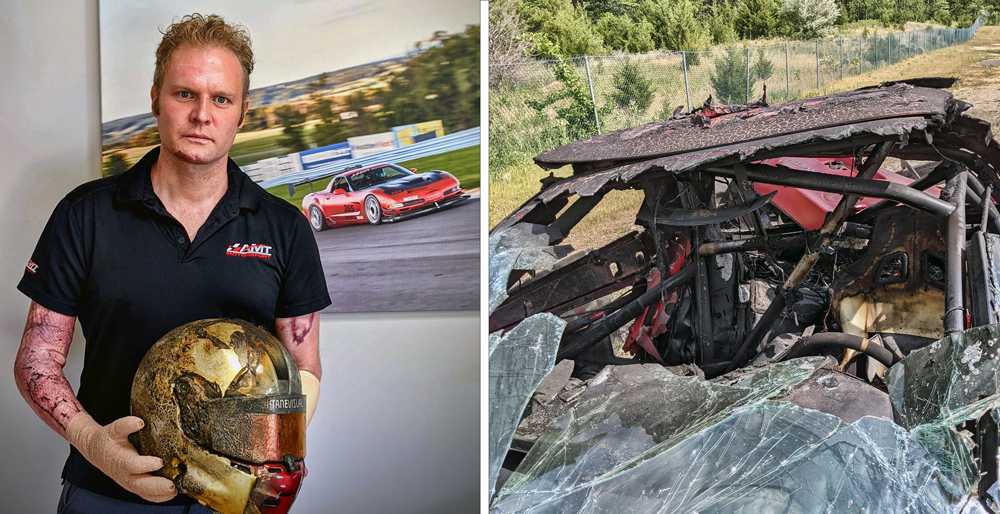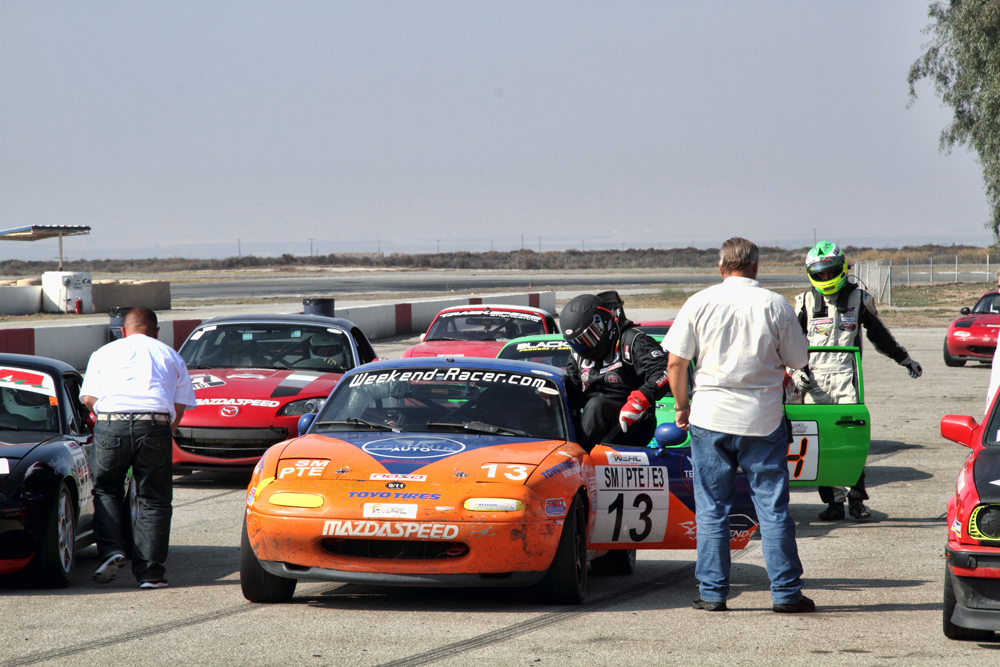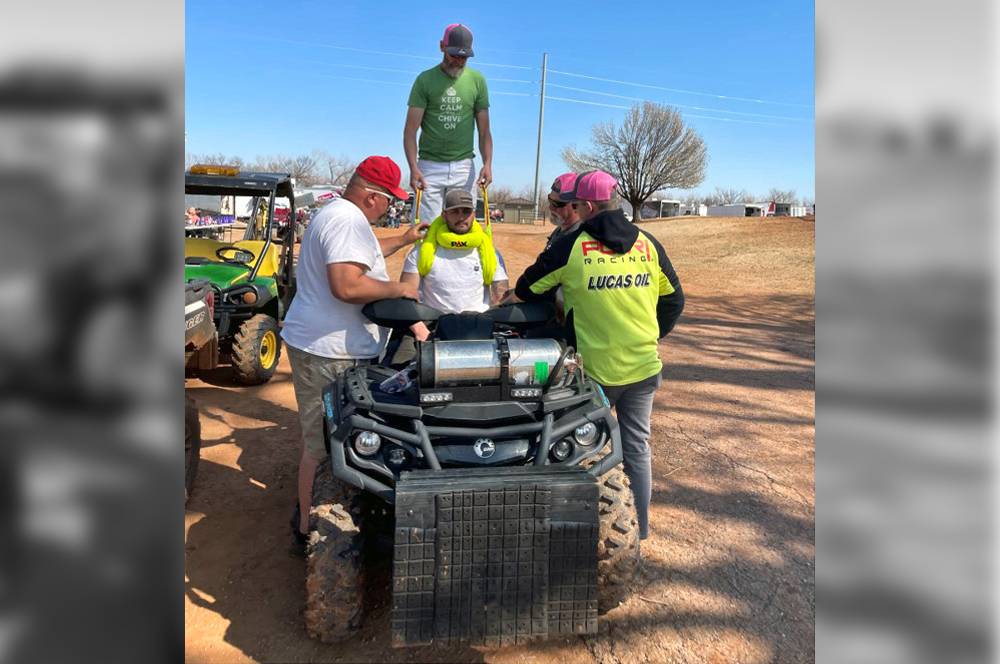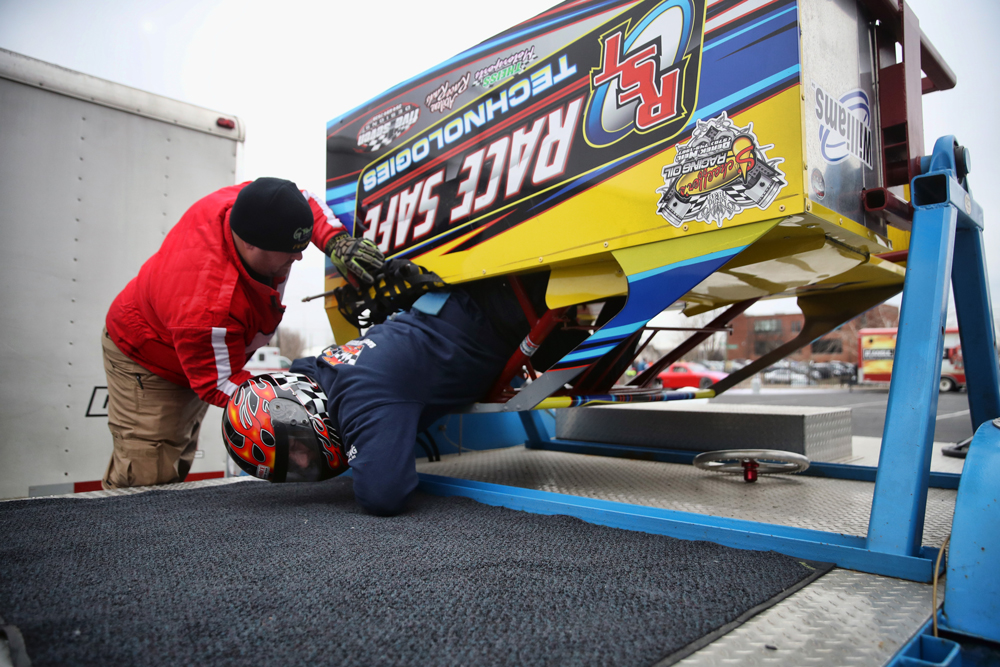Special Report: Degrees of Safety
Fire imparts fear in the hearts of even the most confident racers. So, how well-prepared are today’s drivers, especially in the grassroots and mid-level ranks, to avoid or minimize a serious fire-related injury?
In the catalog of things that can go wrong in auto racing, getting trapped in a burning race car ranks as the most terrifying. Fire sparks an instinctive, elemental fear that drivers have to keep tucked away or else few would venture on track.
Of course, one way to mitigate that fear is to be prepared with the proper training and safety gear that makes such risks manageable. But are most drivers prepared? At the top ranks of motorsports, in the series with huge budgets and millions of viewers, fire safety training is a given. But what about at the grassroots and mid-levels? Local tracks cater to armies of low-budget hobby racers, part-timers, veteran competitors happy in their niche, and hungry young people clawing their way up the racing ladder.
Certainly, there have been huge strides in recent years in fire protection safety gear, especially in the areas of materials and automatic systems. But fire safety gear is no magic bullet. Training is essential. Knowing what to do when blinding smoke is billowing through the cockpit, the car is upside down and flames are flaring up, can literally be the difference between life, death, or long-term pain and incapacity.
We set out to analyze the state of fire safety awareness and preparedness in the sport along with what racers can do to improve their odds should the unthinkable happen.
Practice Makes Perfect
As with everything in racing, speed is of the essence. “In term of an egress situation in fire events, every second absolutely counts,” said Ben O’Connor of Impact Racing, a manufacturer of driver suits, helmets, and other safety gear in Indianapolis, Indiana. “More so in series or types of racing where first responders are not immediately present, like off-road or rally, things like that. On long road courses, the fire safety crew may be at one end of the track and you might be a mile away on the backstraight. In a fire event, every second counts. You may be knocked out for a few seconds and not even know it. And when you come out of it, you may be engulfed in flames, and then you have to figure your way out of the vehicle.”
For a gut-check, real-world example of what can happen when a racing crash leads to a fire, Mark Petronis, owner of AMT Motorsport in Clifton Park, New York, went through just such an ordeal. On May 23, 2021, he was racing his 2004 Corvette in the ST2 class at a NASA Northeast race at New Jersey Motorsports Park. After a passing maneuver went awry, he left the track at 115 mph, slid in the grass, and slammed backward into a tree at 70 mph, rupturing the fuel tank and triggering a fire.

Petronis was unconscious and on fire for three minutes and 15 seconds before volunteers and safety workers extracted him from the car. The Corvette was equipped with a fire suppression system, but it was a manual system, which he was in no condition to operate. Fortunately, Petronis had invested in quality safety gear, including an Alpinestars suit, gloves, shoes, and underwear, and a Stilo ST5 composite helmet. The equipment far exceeded minimum safety specifications, but even so, with Petronis spending that long in a burning environment, he suffered 3rd and 4th degree burns over 35% of his body.
He was flown by medivac helicopter to a burn unit in Philadelphia and spent the next several months in the hospital, part of it in an induced coma. Many surgeries and an arduous recovery followed. Petronis filmed a documentary about his crash and recovery called “Survival” and released it in early 2022 on AMT Motorsport’s YouTube channel.
When not running his business or working his way back into the driver’s seat for track days, Petronis gives driver fire safety and preparedness seminars at races and events, including at the Racing Goes Safer symposium at the 2022 PRI Trade Show. One of the points he emphasizes is the importance of actually practicing fire safety drills.
“For those who have caged, competition cars racing wheel-to-wheel, pretty much any organization is going to test you either at yearly intervals or sometimes a surprise check. But for the most part, once a year you are expected to demonstrate that you can get out of a car between 10 to 15 seconds,” Petronis said. “With my organization it was 10 with the door open, and 15 through the window. And before this thing happened to me, I was certainly one of those guys who did that literally once a year. Maybe I would try it once or twice before the demonstration so I could beat my other competitors in how fast I could get out of the car. In my Corvette I was able to get out in about six seconds when everything was going well.
“On the road racing level, I’ll bet that most drivers aren’t doing that but once or twice a year as per the requirements,” he continued. “And having gone through this thing, realizing that not everything is going to go to plan the way you hope that it does, I guarantee, if guys are practicing one or two times a year going out their driver’s side, no one is practicing going out the passenger side. No one is practicing while wearing a blindfold, as if they couldn’t see because the car is full of smoke. I think on the average, people are doing the minimal amount of training they need to do to get out of a car to pass the test, but I don’t think the vast majority think ‘what if this thing really happens?’”

Ralph C. Browning is the director of safety for Performance Open Wheel Racing inc. (POWRi), based in Belleville, Illinois, and former director of fire safety at Lake Ozark Speedway in Eldon, Missouri. He has 50 years’ experience in track safety in all forms of motorsports, specializing in dirt track safety. He also has 33 years of firefighting and Specialized Rescue and Fire Instructional experience and is a trauma-certified registered nurse, and has his own track safety consulting business. He has seen the full spectrum of driver attitudes on safety issues.
“I would say it is about 40/60—40% do take it seriously and ensure they have excellent fire safety, and 60% do not. It is the ‘It will not happen to me’ or ‘I can’t afford it’ mentality,” he said.
“When it comes to a driver safety perspective, we highly recommend training, but it’s not mandatory in the POWRi Series. In other words, we’re not going to do like F1 or IndyCar or NASCAR and say, ‘You have to prove to me that you can get out of your car in less than 30 seconds.’ We’ve looked at different avenues in trying to ensure that the drivers are aware of safety and that they’re aware of how to get out of their cars in the event of an accident.
“From a safety crew standpoint, we pay a lot of attention to our younger drivers because sometimes their first roll-over is life-changing for them because it scared them so bad,” he continued. “And then there are those who say, ‘That was really great. When is the next time I’m going to roll over?’ As they grow and mature, the degree of safety that a driver puts on themselves is dependent upon what they’ve done in their history. You find those who have had that bad crash, and they are a little more in tune to their safety and how to get in and out of their car, versus the guy who hasn’t had the bad crash yet. So those who have not had the bad crash are the ones who have that ‘it’s not going to happen to me,’ mindset. They learn from their experiences.”
O’Connor is in the safety equipment business, but he said that there’s no substitute for practicing emergency procedures until they become second nature. “I think practice is very valuable because, you never think about it, and then you’re in that situation, and you could be in real trouble if you’re disoriented. Building that muscle memory, practicing it over and over, is going to ensure your best chance of getting out of the vehicle in the quickest time possible.”
Safety training does not have to be overly complex. The gist of it can be boiled down to a short list of priorities. “A lot of people have this misconception that if my car’s on fire, I’m going to hop out and put the car out. That shouldn’t at all be your concern,” Petronis said. “As far as I’m concerned, the only important thing you need to do when the car is on fire is get the hell out of the car.”
Petronis identified a simple order of operations. “Make sure the car is stopped,” he said. “Number two, take off your belts, because you’re not going anywhere unless those are off. Number three, take down your window net because you’re surely not getting through the window if that’s up. Number four, for me, take the steering wheel off if you’re in a car that has a removable steering wheel, and you can’t get out with it still attached. For me, those are the four things—stop the car, seat belts, window net, steering wheel release if you have one, and then get the hell out of there. Forget everything else that’s in there.”
Even with these fundamentals in mind, the order can vary from car to car and series to series. “You don’t always know what the order is. What works for one vehicle, one driver, may be different for somebody else,” O’Connor said. “Maybe taking the steering wheel off is the first thing you do, but maybe it’s not, because of some chassis configuration change, or whatever. It may be better to remove the net first, and then restraints. That’s why you have to practice.”
Following Directions
Racers place a lot of faith in safety gear, and for the most part, that is justified. Safety equipment has come a long way. But drivers still need to be diligent in making sure they are using the gear correctly, as the manufacturer intended.
Part of Petronis’ safety talk involves showing his scorched helmet. Had he not had the visor down, he would be in much worse shape today. “I wouldn’t have much of a face if my visor was up,” he said. “The only reason I have a face is because I had a visor that was down. I stress the importance of that as well.”

Safety preparation also includes selecting parts that won’t hinder safety crews. “Having a properly set up window net, having the latches done in a way that’s most beneficial to egress, being able to reach the latch mechanism and easily undo it, particularly in instances when you’re not right-side up, or there’s a fire involved, you want to make sure that’s the least bit of confusing as possible,” O’Connor said.
“But also set up in a way that first responders can get to it and undo it if need be,” he continued. “Most of the sanctioning bodies have rules about where the latch is located, and many of them will dictate what type of latch mechanism. A lot of that is for that reason—it’s more for the first responder than the individual driver. The driver may have a set-up that works for them, but if the first responders are not aware of that setup, it can cause a lot of confusion and delay in being able to get to you. We do a lot of custom window nets, so we see a lot of latch mechanisms and things like that.”
Sometimes, little details in equipment choice that were overlooked at the time of purchase, or were chosen for aesthetic reasons, can hinder the ability of rescue crews to extract a driver. “Because my belts were black, my suit was black, and my car interior was black, nobody knew where the hell my seatbelts were,” Petronis said. “So I was unconscious, I couldn’t get them off, and neither could anybody else. They were reaching into the car and it was too hot and smokey, so they got a knife to cut my belts off.”
Shared Responsibility
Driver preparation and parts selection is one side of the issue. But when it comes to fire safety, everyone involved in motorsports has a stake in improving awareness and preparedness—drivers, team owners, tracks, and sanctioning bodies. That cooperation can take many forms.
“Part of what I do when I’m traveling around and doing my speeches and seminars, is to encourage people,” Petronis said. “‘Look, you may be a track that has been a little bit lax on safety. What is your plan? What are you going to do to prepare? What are you going to be aware of?’ The onus on safety should not only be on the driver. There should be a shared responsibility between tracks and drivers. I think if everybody took that to heart, there would probably be a lot less overall injuries, especially from fire.”
For sanctions, an evolving rulebook can nudge the effort in the right direction. “Our POWRi safety rules cover the safety requirements for drivers, car construction, and seat requirements. Some rules are put in place to protect the drivers from themselves because they are focused on winning at all costs and not their own safety,” Browning said.

“You take body side panels for instance. Open wheel cars, the midgets and sprint cars, you used to be able to see the driver’s knees. Now, about all you can see is their eyes. So we had to write the rules a little differently to ensure that their safety is protected in limiting the size of the side panels. Because everything is about aerodynamics now, and weight, which can mean the difference between first place and third place. So we allow them to run the side panels on the right side and the left side, but they can only be 36 inches tall. They have to have 150 square inches of open space. That’s so that if you come to rest on your lid, completely upside down, you can still get out the side of the car.
“The open wheel racing industry is moving toward requiring on-board fire extinguishers for sprint cars and midgets,” Browning continued. “This was missing due to a lack of suitable systems for the open wheel cars. There have been great advances in this technology. The World Racing Group has adopted the technology and is requiring it for their sprint cars beginning in 2023 and in the Xtreme Series beginning in 2024. I am confident that POWRi and USAC will follow since many of the same cars and drivers drive in all three sanctioning bodies.”
Budgets are an issue at every level of racing, and some tracks eke out just enough profit to keep the gates open. Sanctioning bodies have a role to play here, too. “At POWRi, we bring everything with us to support all our traveling series, from the micro sprints, midgets, to the wing and non-wing 410 sprint cars. We do an assessment of the fire and rescue capability the track has on hand and then provide the necessary fire extinguishing agent and specialized tools for rescue that meet our standard. Many tracks do not have the correct fire extinguishing agent because of the fuel our cars race with due to cost. So we provide the AR-AFFF Encapsulating foam for them. One thing we want the local track safety personnel to understand is that the POWRi Fire Safety Team is not there to replace them but to enhance their capability.”
There are plenty of race tracks that take the lead on issues of safety as well. “Some tracks are very progressive,” Browning said, “and those are usually tracks that are owned by previous drivers. Port City Raceway outside of Tulsa, Oklahoma, is one. Shane Stewart, a former World of Outlaws sprint car driver, owns that track. He is keenly aware of safety and what it means, and they have a good program. They have their own safety team; they have a fire rescue team provided by a local fire department. At Lake Ozark Speedway, they use a combination of paramedics and paid professional firefighters.”
Fire safety can be an uncomfortable subject, but racers are open to the message. On his speaking tours, Petronis said he has had hundreds of drivers tell him how his message has changed their perceptions and actions.
“I go to these track days now and I’m recognizable, for one. It’s hard to miss the guy with all the burned up arms and hands and whatnot,” he said. “So everybody kind of knows who I am. If they didn’t before they pretty much do now. They’ll come up to me and say, ‘I’m wearing this firesuit because of you, I swapped out my fire system to an automatic.’
“It doesn’t take many people to get into my ear to tell me I’m affecting some sort of positive change for me to feel like what I’m doing is worth it. I don’t need to be touched by tens of thousands of people. If a dozen people a year tell me that they took it to heart and they’re safer because of it, then I’m happy,” he concluded.
Sources
Mark Petronis, AMT Motorsport
amtmotorsport.com
Impact Racing
impactraceproducts.com
POWRi Racing
powri.com
Resources
National Fire Protection Association Standard 610: Guide for Emergency and Safety Operations at Motorsports Venues
nfpa.org
Racing Goes Safer
racinggoessafer.org
 MEMBERSHIP LOGIN
MEMBERSHIP LOGIN JOIN PRI
JOIN PRI


